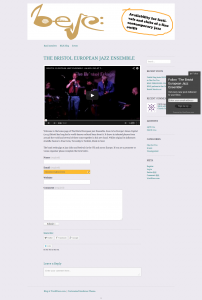Copyright for Images, Video and Copy
I haven’t written much about copyright, so here are a few guidelines I follow to be on the safe side.
Images
I found this bulletin “Alert – Photo and image copyright compliance” in the Churches Together in England newsletter, CTE News July 2014. Whilst this article addresses churches the main point applies to all organisations with websites.
I always warn my clients about images. For some reason they seem to cause the most trouble. I suppose most websites feature many images and far fewer videos or audio recordings and so the likelihood of a mistake is higher than for other media. Also tracking down the owner and asking permission is a hassle particularly if the owner lives on the other side of the world.
However, the dangers are real. You have three options.
- Use your own images. If you carry a digital camera or a mobile phone you can record useful images as you encounter them. You can scan images you draw yourself. If you’re really ambitious learn to use Photoshop or one of the other similar tools.
- If you have permission then attribute the image. I use the title attribute in the html img tag, which means the attribution appears when the reader hovers over the image. Captions are equally good and the attribution is always visible. Best practice is to use these if your website features members’ images, for example. So, it is best to attribute your own images if they feature on an organisation’s site, even if you put them there. Make it clear the copyright of images belongs to the site unless otherwise stated. If you use free images, and there are many sites that supply them, follow the instructions about attribution. Remember many free image sites charge for images used anywhere other than on websites. Don’t assume you can use an image in any way you like just because it is free to use online.
- Get permission to use an image if it isn’t on a free site. This may be a hassle but occasionally if there is no alternative it might be worth it. Some sites might charge to use images, presumably a lot less than the fine.
Videos
Video seems to be less of a problem than images. When you upload your video to YouTube, YouTube becomes in effect its owner. Any website can embed a YouTube video without breaching copyright. Presumably this is because the video is attributed back to the site and anyone who views it registers on the YouTube site. Take care with other video sources, check their terms and conditions.
Text
This is the least problematic. Unless you’re planning to copy the entire contents of a paper, blog post or book onto your website you’re in the clear.
You can reproduce short extracts from a text on your own site. It should be attributed and if it is available a link to the full text is always worth adding. This has been standard practice in academic writing for many years. Linking to the full text, where possible, is new and has many advantages. The reader has something to follow-up if they are interested and you provide a back-link to someone’s site. In time they or others may do the same for you.
As far as I’m aware ideas are not copyrighted. So, there is no restriction on expressing an idea in your own words. What you choose to attribute is a matter of judgement. For example, I sometimes take the structure of someone’s copy and adapt it to my own ends. The overall flow of logic may shadow theirs but the content is entirely mine. Should this be attributed? It does depend upon how much they have influenced your own copy and you may wish to link your copy to theirs so your readers can see both arguments. On the other hand if you are taking an entirely new direction there is little point in muddying the waters with an irrelevant link.
Do you agree with the basic rule: “If in doubt, leave it out!”?
